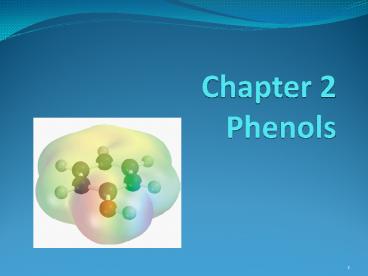Chapter 2 Phenols - PowerPoint PPT Presentation
1 / 28
Title:
Chapter 2 Phenols
Description:
... of Phenols Phenols was first isolated from coal tar. Phenol is an important industrial chemical. Major use is in phenolic resins for adhesives and plastics. – PowerPoint PPT presentation
Number of Views:883
Avg rating:3.0/5.0
Title: Chapter 2 Phenols
1
Chapter 2Phenols
2
1-Nomenclature of Phenols
- Phenols are compounds that have hydroxyl group
bonded directly to benzene ring.
Named on basis of phenol as parent, substituents
listed in alphabetical order.
3
(No Transcript)
4
(No Transcript)
5
2-Physical Properties
1-The OH group of phenols allows hydrogen bonding
to other phenol molecules and to water.
2-Compared to compounds of similar size and
molecular weight, hydrogen bonding in phenol
raises its melting point, boiling point, and
solubility in water.
6
(No Transcript)
7
Hydrogen Bonding of Phenols
8
Hydrogen Bonding with Water
9
3- Acidity of Phenols
- Most characteristic property of phenols is their
acidity. - Phenols(pKa 10) are more acidic than
alcohols(pKa 16-20) but less acidic than
Carboxylic acids (pKa 5).
10
To explain why, lets compare the ionization of
Ethanol and Phenols
11
(No Transcript)
12
(No Transcript)
13
Substituent Effects on the Acidity of Phenols.
1-Electron-releasing groups ( CH3, OCH3) have
little or no effect.
2-Electron-withdrawing groups ( NO2, Cl, OH)
increase acidity.
3- Multiple substituent of electron- withdrawing
group greatly increase acidity of phenols.
14
Electron-releasing groups have little or no
effect.
Electron-withdrawing groups increase acidity.
15
Effect of electron-withdrawing groups is
mostpronounced at ortho and para positions.
Effect of strong electron-withdrawing groups is
cumulative.
16
(No Transcript)
17
4-Sources of Phenols
- Phenols was first isolated from coal tar.
- Phenol is an important industrial chemical.
- Major use is in phenolic resins for adhesives and
plastics.
18
Industrial preparation of Phenols
19
Laboratory Synthesis of Phenols
20
5- Reactions of Phenols
A hydroxyl group is very powerful activating
substituent, and electrophilic aromatic
substitution in phenol occurs far faster, and
under milder condition, than in benzene. a-
Halogenation
21
b- Sulfonation
22
c- Nitration
d- Nitrosation
23
d-Friedal Crafts Alkylation
e-Friedal Crafts Acylation
24
In the absence of ALCL3, However O-acylation
occurs instead.
25
(No Transcript)
26
f- Reaction with arenediazonium salts.
27
6- Aspirin and the Klobe Schmitt Reaction.
28
Preparation of Salicylic Acid
This reaction is called the Kolbe- Schmitt
reaction. Acidification coverts the sodium salt
shown above to salicylic acid.































